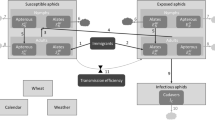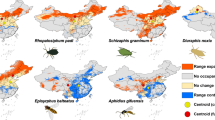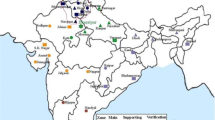Abstract
We expose here a detailed spatially explicit model of aphid population dynamics at the scale of a whole country (Metropolitan France). It is based on convection–diffusion-reaction equations, driven by abiotic and biotic factors. The target species is the grain aphid, Sitobion avenae F., considering both its winged and apterous morphs. In this preliminary work, simulations for year 2004 (an outbreak case) produced realistic aphid densities, and showed that both spatial and temporal S. avenae population dynamics can be represented as an irregular wave of population peak densities from southwest to northeast of the country, driven by gradients or differences in temperature, wheat phenology, and wheat surfaces. This wave pattern fits well to our knowledge of S. avenae phenology. The effects of three insecticide spray regimes were simulated in five different sites and showed that insecticide sprays were ineffective in terms of yield increase after wheat flowering. After suitable validation, which will require some further years of observations, the model will be used to forecast aphid densities in real time at any date or growth stage of the crop anywhere in the country. It will be the backbone of a decision support system, forecasting yield losses at the level of a field. The model intends then to complete the punctual forecasting provided by older models by a comprehensive spatial view on a large area and leads to the diminution of insecticide sprayings in wheat crops.



Similar content being viewed by others
References
Akli M (1984) Effets des facteurs variétal et phénologique de six cultivars de blé d'hiver sur le potentiel biotique de Sitobion avenae Fabricius. Mémoire DEA, Université de Rennes 1. Ecole Nationale Supérieure Agronomique de Rennes, Rennes
Al Hassan D, Parisey N, Burel F, Plantegenest M, Kindlmann P, Butet A (2012) Relationship between the abundance of aphids and their natural enemies in cereal fields and landscape composition. Eur J Environ Sci 2:89–101
Andow DA, Kareiva PM, Levin SA, Okubo A (1990) Spread of invading organisms. Landsc Ecol 4:177–188
Arléry R (1979) Le climat de la France. Direction de la Météorologie Nationale, Paris
Beament JW, Treherne JE (1966) Advances in Insect Physiology, vol 3. Elsevier Science and Technology Books, London
Berestycki H, Rossi L (2008) Reaction–diffusion equations for population dynamics with forced speed I—the case of the whole space. Discret Contin Dyn Syst 21:41–67
Butault J-P, Dedryver C-A, Gary C, Guichard L, Jacquet F, Meynard J-M, Nicot P, Pitrat M, Reau R, Sauphanor B, Savini I, Volay T (2010) Quelles voies pour réduire l'usage des pesticides ? Synthèse du rapport d’étude. Ecophyto R et D, INRA, France
Cantrell RS, Cosner C (2003) Spatial ecology via reaction–diffusion equations. Wiley, London
Carter N, Dixon AFG, Rabbinge R (1982) Cereal aphid populations: biology, simulation, and prediction. Center for Agricultural Publishing and Documentation. Pudoc, Wageningen
Ciss M, Parisey N, Dedryver C-A, Pierre J-S (2013) Understanding flying insect dispersion: Multiscale analyses of fragmented landscapes. Ecol Inform 14:59–63
Compton SG (2002) Sailing with the wind: dispersal by small flying insects. Dispersal Ecology. In: Bullock JM, Kenward RE, Hails RS (eds) The 42nd Symposium of the British Ecological Society, 2–5 April 2001, The University of Reading. Blackwell Science, Oxford, pp 113–133
Couteux A, Lejeune V (2013) Index phytosanitaire ACTA. Acta, Paris
Dean GJ (1974) Effect of temperature on the cereal aphids Metopolophium dirhodum (Wlk.), Rhopalosiphum padi (L.), and Macrosiphum avenae (F.) (Hem., Aphididae). Bull Entomol Res 63:401–409
Dedryver CA, Fiévet M, Plantegenest M, Vialatte A (2009) An overview of the functioning of Sitobion avenae populations at three spatial scales in France. Redia 92:159–162
Dedryver CA, Fougeroux A, De La Messeliere C, Pierre JS, Taupin P (1987) Typologie des courbes de fluctuations des populations de pucerons des céréales sur le blé d'hiver dans le Bassin parisien et élaboration d'un modèle de prévision des pullulations de Sitobion avenae. In Annales de la première conférence sur les ravageurs en agriculture, 1–3 décembre 1987, pp 93–104
Dedryver CA, Gelle A (1982) Biologie des pucerons des céréales dans l'ouest de la France IV—étude de l'hivernation de populations anholocycliques de Rhopalosiphum padi L., Metopolophium dirhodum Wlk. et Sitobion avenae F. sur repousses de céréales dans trois stations de Bretagne et du Bassin parisien. Acta Oecologica Oecologia Applicata 3:341–342
Dedryver CA, Le Ralec A, Fabre F (2010) The conflicting relationships between aphids and men: a review of aphid damage and control strategies. C R Biol 333:539–553
Dedryver CA, Tanguy S (1984) Biologie des pucerons des céréales dans l'ouest de la France V—influence de la date de semis du blé d'hiver sur les modalités d'infestation des parcelles par Sitobion avenae, Metopolophium dirhodum, Rhopalosiphum padi et sur le développement de leur population de printemps. Agronomie 4:711–719
Dixon AFG (1987) Cereal aphids as an applied problem. Agric Zool Rev 2:1–57
Dixon AFG (1998) Aphid Ecology, Ed Springer. Chapman and Hall, London
Dry WW, Taylor LR (1970) Light and temperature thresholds for take-off by aphids. J Anim Ecol 39:493–504
FAO (2010) Food and Agriculture Organization (FAO) for the United Nations website. Accessed 30th January, 2013. In. http://faostat.fao.org/site/339/default.aspx
Fiévet V, Dedryver CA, Plantegenest M, Simon JC, Outreman Y (2007) Aphid colony turn-over influences the spatial distribution of the grain aphid Sitobion avenae over the wheat growing season. Agric For Entomol 9:125–134
Fisher RA (1937) The wave of advance of advantageous genes. Ann Eugen 7:335–369
Hadeler KP, Hillen T, Lewis MA (2009) Biological modeling with quiescent phases. In: Cantrell S, Cosner C, Ruan S (eds) Spatial Ecology. CRC Press, Boca Raton, pp 101–127
Hadeler KP, Lewis MA (2002) Spatial dynamics of the diffusive logistic equation with a sedentary compartment. Can Appl Math Q 10:472–499
Hansen LM (2006) Models for spring migration of two aphid species Sitobion avenae (F) and Rhopalosiphum padi (L.) infesting cereals in areas where they are entirely holocyclic. Agric For Entomol 8:83–88
Hardie J (1993) Flight behavior in migrating insects. J Agric Entomol 10:239–245
Kennedy J, Booth C (1963) Free flight of aphids in the laboratory. J Exp Biol 40:67–85
Kindlmann P, Jarošík V, Dixon AFG (2007) Population dynamics. In: Van Emden H, Harrington R (eds) Aphids as crop pests. CAB International, Oxon, United Kingdom, pp 311–329
Kolmogorov A, Petrovsky I, Piskunov N (1937) Etude de l'équation de la diffusion avec croissance de la quantité de matière et son application à un problème biologique. Bulletin de Mathématiques de l'Université de Moscou Série internationale A 1:1–26
Latteur G, Oger R (1987) Principes de base du système d'avertissement relatif à la lutte contre les pucerons des froments d'hiver en Belgique. In Annales de la première conférence sur les ravageurs en agriculture, 1–3 décembre 1987, Paris, pp 129–136
Llewellyn KS, Loxdale HD (2003) Migration and genetic structure of the grain aphid (Sitobion avenae) in Britain related to climate and clonal fluctuation as revealed using microsatellites. Mol Ecol 12:21–34
Loxdale HD, Hardie J, Halbert S, Foottit R, Kidd NAC, Carter CI (1993) The relative importance of short and long-range movement of flying aphids. Biol Rev 68:291–311
Loxdale HD, Lushai G (1999) Slaves of the environment: the movement of herbivorous insects in relation to their ecology and genotype. Phil Trans R Soc London B 354:1479–1498
Loxdale HD, Tarr IJ, Weber CP, Brookes CP, Digby PGN, Castañera P (1985) Electrophoretic study of enzymes from cereal aphid populations. III. Spatial and temporal genetic variation of populations of Sitobion avenae (F.) (Hemiptera: Aphididae). Bull Entomol Res 75:121–142
Lutscher F, Pachepsky E, Lewis MA (2005) The effect of dispersal patterns on stream populations. Siam Rev 47:749–772
Moericke B (1955) Über die LebensGewohnheiten der geflügelten Blattläuse (Aphidina) unter besonderer Berücksichtigung des Verhaltens beim Landen. Z Angew Entomol 37:29–91
Mozner Z, Tabi A, Csutora M (2012) Modifying the yield factor based on more efficient use of fertilizer: the environmental impacts of intensive and extensive agricultural practices. Ecol Indic 16:58–66
Murray JD (2003) Mathematical Biology—Tome 2: Spatial Models and Biomedical Applications. Interdisciplinary Applied Mathematics, Berlin
Needelman BA, Ruppert DE, Vaughan RE (2007) The role of ditch soil formation and redox biogeochemistry in mitigating nutrient and pollutant losses from agriculture. J Soil Water Conserv 62:207–215
Okubo A (1980) Diffusion and ecological problems: mathematical models. Springer, New York
Pachepsky E, Lutscher F, Nisbet RM, Lewis MA (2005) Persistence, spread, and the drift paradox. Theor Popul Biol 67:61–73
Pärn J, Pinay G, Mander U (2012) Indicators of nutrients transport from agricultural catchments under temperate climate: a review. Ecol Indic 22:4–15
Parry HR, Evans AJ, Morgan D (2006) Aphid population response to agricultural landscape change: a spatially explicit, individual-based model. Ecol Model 199:451–463
Pierre JS (2007) Les mathématiques contre les pucerons. Biofutur 279:26
Pierre JS, Dedryver CA (1984) Un modèle de régression multiple appliqué à la prévision des pullulations d'un puceron des céréales: Sitobion avenae F., sur ble d'hiver. Acta Oecologica-Oecologia Applicata 5:153–.172
Plantegenest M (1995) Modélisation de la dynamique de population du puceron des épis (Sitobion avenae F.) sur le blé d'hiver au printemps et en été—Application au raisonnement de la lutte chimique. Thèse, Université François Rabelais, Tours, France
Plantegenest M, Kindlmann P (1999) Evolutionarily stable strategies of migration in heterogeneous environments. Evol Ecol 13:229–244
Plantegenest M, Pierre JS, Dedryver CA, Kindlmann P (2001) Assessment of the relative impact of different natural enemies on population dynamics of the grain aphid Sitobion avenae in the field. Ecol Entomol 26:404–410
Plantegenest M, Pierre JS, Van Waetermeulen X, Astruc E (1999) COLIBRI: les bases scientifiques d'un modèle de prévision des populations du puceron des épis Sitobion avenae. Phytoma la Defense des Vegetaux 516:26–29
R Development Core Team (2012) R: A Language and Environment for Statistical Computing. In. R Foundation for Statistical Computing, Vienna
Rabbinge R, Ankersmit GW, Pak GA (1979) Epidemiology and simulation of population development of Sitobion avenae in winter wheat. Netherlands J Plant Pathol 85:197–220
Rask M, Olin M, Ruuhijarvi J (2010) Fish-based assessment of ecological status of Finnish lakes loaded by diffuse nutrient pollution from agriculture. Fish Manag Ecol 17:126–133
Richter O, Moenickes S, Suhling F (2012) Modeling the effect of temperature on the range expansion of species by reaction–diffusion equations. Math Biosci 235:171–181
Robinet C (2006) Modélisation mathématique des phénomènes d’invasion en écologie : exemple de la chenille processionnaire du pin. Thèse, Ecole des Hautes Etudes en Sciences Sociales, Paris, France
Roques L (2004) Equations de réaction-diffusion non-linéaires et modélisation en écologie. Thèse, Université Pierre et Marie Curie, Paris 6, Paris, France
Roques L, Auger-Rozenberg MA, Roques A (2008) Modeling the impact of an invasive insect via reaction–diffusion. Math Biosci 216:47–55
Rossberg D, Freier B, Holz F, Wenzel V (1986) PESTSIM-MAC A model for simulation of Macrosiphum avenae F. populations. In Tagungsbericht Akademie der Landwirtschaftswissenschaften der DDR (German DR), Vol 242, Berlin, pp 87–100
Saiyed IM, Bullock PR, Sapirstein HD, Finlay GJ, Jarvis CK (2009) Thermal time models for estimating wheat phenological development and weather-based relationships to wheat quality. Can J Plant Sci 89:429–439
Salman AMA (2006) Influence of temperature on the developmental rate and reproduction of the English grain aphid, Sitobion avenae (Fabricius) (Homoptera: Aphididae). Arab Univ J Agric Sci, Ain Shams Univ, Cairo 14:789–801
Saltelli A, Chan K, Scott EM (2009) Sensitivity Analysis. John Wiley and Sons Publication, Chichester
Shigesada N, Kawasaki K (1997) Biological invasions: theory and practice. Oxford University Press, Oxford
Simon JC, Baumann S, Sunnucks P, Hebert PDN, Pierre JS, Le Gallic JF, Dedryver CA (1999) Reproductive mode and population genetic structure of the cereal aphid Sitobion avenae studied using phenotypic and microsatellite markers. Mol Ecol 8:531–545
Skellam JG (1951) Random dispersal in theoretical populations. Biometrika 38:196–218
Smoller J (1994) Shockwaves and reaction–diffusion equations—2nd edition. Springer, Berlin
Tatchell GM (1989) An estimate of the potential economic losses to some crops due to aphids in Britain. Crop Prot 8:25–29
Turchin P (1998) Quantitative Analysis of Movement: Measuring and Modeling Population Redistribution in Animals and Plants. Sinauer, Sunderland
Vereijken PH (1979) Feeding and multiplication of three cereal aphid species and their effect on yield of winter wheat. R. Pudoc, PhD Thesis, Wageningen, Netherland
Vialatte A, Dedryver CA, Camus D, Plantegenest M (2005) Vers un OAD de traitement des pucerons des épis au printemps. Compte-rendus de la VIIeme conférence internationale sur les ravageurs en agriculture Montpellier, France, octobre 2005 CD-Rom Acariens-CIRA: 2-905550-02-3
Vialatte A, Plantegenest M, Simon JC, Dedryver CA (2007) Farm-scale assessment of movement patterns and colonization dynamics of the grain aphid in arable crops and hedgerows. Agric For Entomol 9:337–346
Walters KFA, Dixon AFG (1984) The effect of temperature and wind on the flight activity of cereal aphids. Ann Appl Biol 104:17–26
Watt AD (1979) The effect of cereal growth stages on the reproductive activity of Sitobion avenae and Metopolophium dirhodum. Ann Appl Biol 91:147–157
Watt AD, Dixon AFG (1981) The role of cereal growth stages and crowding in the induction of alate in Sitobion avenae and its consequences for population growth. Ecol Entomol 6:441–447
Wohlfahrt J, Colin F, Assaghir Z, Bockstaller C (2010) Assessing the impact of the spatial arrangement of agricultural practices on pesticide runoff in small catchments: combining hydrological modeling and supervised learning. Ecol Indic 10:826–839
Zadoks JC, Chang TT, Konzak CF (1977) Un code décimal pour les stades de croissance des céréales. Phytiatrie-Phytopharmacie 26:129–140
Acknowledgments
This research was managed in collaboration with INRA, the University of Rennes 1 and Arvalis-Institut du Végétal. It was funded by a CIFRE grant from the French Ministry of National Education, Advanced Instruction, and Research and from Arvalis-Institut du Végétal. The authors are also grateful to Bayer Cropscience France and Makhteshim Agan France for providing field data for calculation of aphid growth rate. We thank the ASP (Agence de Services et de Paiement) for providing the “Registre Parcellaire Graphique” (RPG) Geographic Information System. We are also grateful to Vincent Faloya (INRA UMR 1349 IGEPP) and Cédric Wolf (Université Rennes1, CNRS UMR 6553 ECOBIO) for scientific exchanges. We thank M. Jean-François Chollet and the anonymous reviewers for their helpful comments.
Author information
Authors and Affiliations
Corresponding author
Additional information
Responsible editor: Michael Matthies
Electronic supplementary material
Below is the link to the electronic supplementary material.
ESM 1
(DOCX 34 kb)
Rights and permissions
About this article
Cite this article
Ciss, M., Parisey, N., Moreau, F. et al. A spatiotemporal model for predicting grain aphid population dynamics and optimizing insecticide sprays at the scale of continental France. Environ Sci Pollut Res 21, 4819–4827 (2014). https://doi.org/10.1007/s11356-013-2245-1
Received:
Accepted:
Published:
Issue Date:
DOI: https://doi.org/10.1007/s11356-013-2245-1




